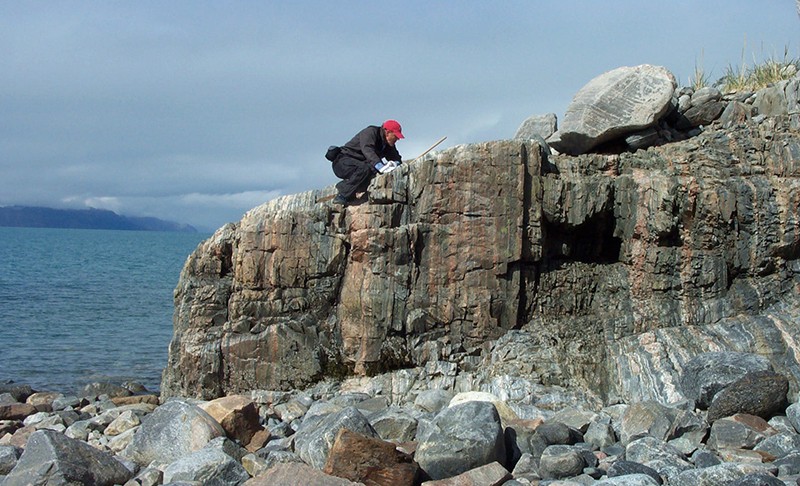Taking Greenland’s geology to another dimension
Geologist and former surf dude William Glassley has spent six field seasons studying the ancient rock of coastal Greenland. As he probes our planet’s youth, three billion years ago, many will envy him. His brief but ambitious A Wilder Time demonstrates that there’s nothing like geology for acquainting you with the joys of remote isolation at other people’s expense.
The area he explores, with Danish colleagues Kai Sørensen and John Korstgård, is vast: part of the coastal fringe of ice-smoothed rock and periglacial tundra that extends like a valance around Greenland’s enormous central ice cap. There is sea to the west, crumbling ice cliffs 150 kilometres and more to the east. A Wilder Time sees our heroes marooned in this wilderness, alone in the short summer’s perpetual day. Glassley eloquently evokes a place where land feathers into Arctic sea, ice floes glide by on mirror-smooth tongues of clear, frigid water and silence reigns.
What drew the companions there might sound, by contrast, like a storm in an academic teacup. Someone (tactfully left unnamed) had published a paper attacking the established geological view that the study area — between Nordre Isortoq in the south and Disko Island to the north — is part of the roots of an ancient mountain range, the Nagssugtoqidian mobile belt. Geologists are familiar with these Inuit place-names, many ending in ‘oq’. Pronunciation should sound, the late Stephen Moorbath (an isotope geochemist and geochronologist) once told me, “like a piano string being cut at the bottom of the ocean”.
Moorbath helped to make the area famous by finding what are still among the oldest known rocks on Earth, almost 3.8 billion years old. In the 1960s and 1970s, geologists Arthur Escher and Juan Watterson mapped these high-grade metamorphic melanges of altered sediments, mantle rocks and ocean-floor basalts. In the 1980s, Feiko Kalsbeek, Bob Pidgeon and Paul Taylor interpreted it all in the light of plate tectonics. The distinctive east–west shear zones that transected the region were, they said, sutures left by the most ancient plate-tectonic collisions on our planet, during the early Proterozoic eon, which began around 2.5 billion years ago. But seeds of doubt were cast. The new paper made fundamental challenges to earlier interpretations that seemed themselves so misguided and riddled with errors and misconceptions that they could not go unanswered.
Such is the scientific narrative underpinning A Wilder Time, whose rather overcomplicated structure arrives at a satisfying conclusion. The epilogue demonstrates how Glassley’s team confirmed and even refined the original interpretation of the mobile belts, putting its assailants to flight.
Natural scientists may be the only intellectuals these days who find themselves routinely exposed to the transformative experience of wilderness. Yet (as I have seen during desert fieldwork in the Middle East) on many of them it seems wasted. This may not be their fault. Expeditions, such as Glassley’s, are a lesson in how travel can narrow the mind. It is hard enough to keep focused on the work when trying to cope with midges, heat, cold, disorientation, altitude and homesickness, never mind dehydration, disgusting camp food and the physical consequences. It takes a deep attunement to the wild’s allure to keep appreciating the surroundings.
Glassley’s vivid impressions of East Greenland attempt what few scientist-writers try: to explore beyond the comfort zone of his field. Followers of the medieval philosopher Duns Scotus coined the terms haecceity (‘thisness’, of specific things) and quiddity (‘whatness’, of the classifier). These are ‘science’. Glassley tries also to grasp something beyond: the noumenon, an ineffable inner reality in things that cannot be discerned by the senses.
Not everyone experiences this psychological epiphany. Scientists sometimes have it trained out of them by the relentless insistence on cold measurement. Glassley, by contrast, seems obsessed with our limitations when it comes to grasping the wholeness of the world. He questions, for instance, how our ‘reality’ contrasts with, say, a seal’s, or a fish’s. Absenting himself from camp, he wanders alone with his reflections, and attempts closer communion with the hidden genius of place.
Although he repeatedly explains what he’s attempting (a scientist’s tendency to write abstracts for everything?), he is not always successful; yet I enjoyed and admired the attempt. What he gropes for requires art, not analysis. Perhaps that was why I kept returning to Hugh MacDiarmid’s great 1934 poem, ‘On a Raised Beach’, which explores the limitations of science in expressing the wholeness of nature. After an opening parody of scientific language, the poet observes: “Deep conviction or preference can seldom/Find direct terms in which to express itself”.
doi: 10.1038/d41586-018-01571-8


Nenhum comentário:
Postar um comentário
Observação: somente um membro deste blog pode postar um comentário.